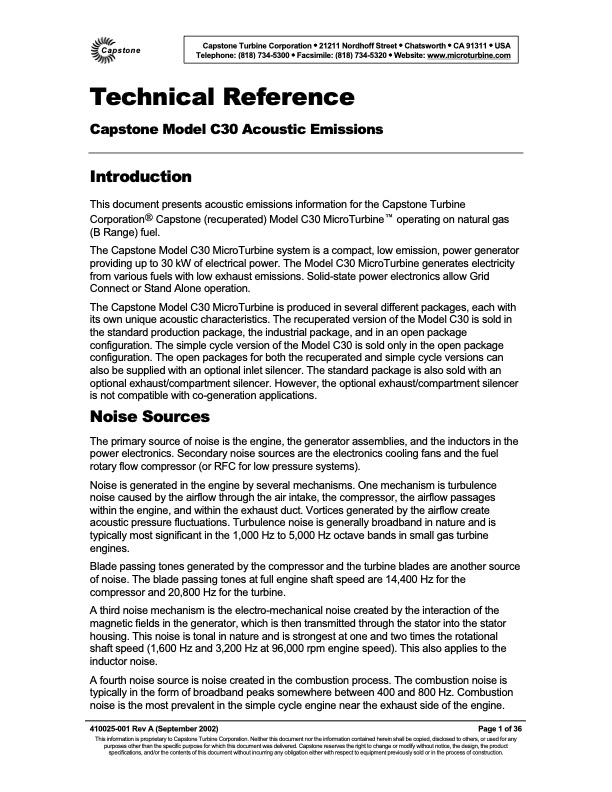
PDF Publication Title:
Text from PDF Page: 001
Capstone Capstone Turbine Corporation • 21211 Nordhoff Street • Chatsworth • CA 91311 • USA Telephone: (818) 734-5300 • Facsimile: (818) 734-5320 • Website: www.microturbine.com Technical Reference Capstone Model C30 Acoustic Emissions Introduction This document presents acoustic emissions information for the Capstone Turbine Corporation Capstone (recuperated) Model C30 MicroTurbine operating on natural gas (B Range) fuel. The Capstone Model C30 MicroTurbine system is a compact, low emission, power generator providing up to 30 kW of electrical power. The Model C30 MicroTurbine generates electricity from various fuels with low exhaust emissions. Solid-state power electronics allow Grid Connect or Stand Alone operation. The Capstone Model C30 MicroTurbine is produced in several different packages, each with its own unique acoustic characteristics. The recuperated version of the Model C30 is sold in the standard production package, the industrial package, and in an open package configuration. The simple cycle version of the Model C30 is sold only in the open package configuration. The open packages for both the recuperated and simple cycle versions can also be supplied with an optional inlet silencer. The standard package is also sold with an optional exhaust/compartment silencer. However, the optional exhaust/compartment silencer is not compatible with co-generation applications. Noise Sources The primary source of noise is the engine, the generator assemblies, and the inductors in the power electronics. Secondary noise sources are the electronics cooling fans and the fuel rotary flow compressor (or RFC for low pressure systems). Noise is generated in the engine by several mechanisms. One mechanism is turbulence noise caused by the airflow through the air intake, the compressor, the airflow passages within the engine, and within the exhaust duct. Vortices generated by the airflow create acoustic pressure fluctuations. Turbulence noise is generally broadband in nature and is typically most significant in the 1,000 Hz to 5,000 Hz octave bands in small gas turbine engines. Blade passing tones generated by the compressor and the turbine blades are another source of noise. The blade passing tones at full engine shaft speed are 14,400 Hz for the compressor and 20,800 Hz for the turbine. A third noise mechanism is the electro-mechanical noise created by the interaction of the magnetic fields in the generator, which is then transmitted through the stator into the stator housing. This noise is tonal in nature and is strongest at one and two times the rotational shaft speed (1,600 Hz and 3,200 Hz at 96,000 rpm engine speed). This also applies to the inductor noise. A fourth noise source is noise created in the combustion process. The combustion noise is typically in the form of broadband peaks somewhere between 400 and 800 Hz. Combustion noise is the most prevalent in the simple cycle engine near the exhaust side of the engine. 410025-001 Rev A (September 2002) Page 1 of 36 This information is proprietary to Capstone Turbine Corporation. Neither this document nor the information contained herein shall be copied, disclosed to others, or used for any purposes other than the specific purpose for which this document was delivered. Capstone reserves the right to change or modify without notice, the design, the product specifications, and/or the contents of this document without incurring any obligation either with respect to equipment previously sold or in the process of construction.PDF Image | Guide for Capstone Turbine Model Number

PDF Search Title:
Guide for Capstone Turbine Model NumberOriginal File Name Searched:
410025_C30_Acoustics.pdfDIY PDF Search: Google It | Yahoo | Bing
Capstone Turbine and Microturbine: Capstone microturbines used and new surplus for sale listing More Info
Consulting and Strategy Services: Need help with Capstone Turbine, sizing systems, applications, or renewable energy strategy, we are here to assist More Info
Container Lumber Dry Kiln: Since 1991 developing and innovating dry kilns using standard shipping containers More Info
Supercritical CO2 Lumber Dry Kiln: Compact fast drying in 3 days or less for small amounts of wood and lumber drying More Info
BitCoin Mining: Bitcoin Mining and Cryptocurrency... More Info
Publications: Capstone Turbine publications for microturbine and distributed energy More Info
FileMaker Software for Renewable Energy Developing database software for the renewable energy industry More Info
CO2 Gas to Liquids On-Demand Production Cart Developing a supercritical CO2 to alcohol on-demand production system (via Nafion reverse fuel cell) More Info
Stranded Gas for low cost power Bitcoin Mining Using stranded gas for generators may provide breakthrough low power costs for cryptocurrency miners. More Info
| CONTACT TEL: 608-238-6001 Email: greg@globalmicroturbine.com | RSS | AMP |